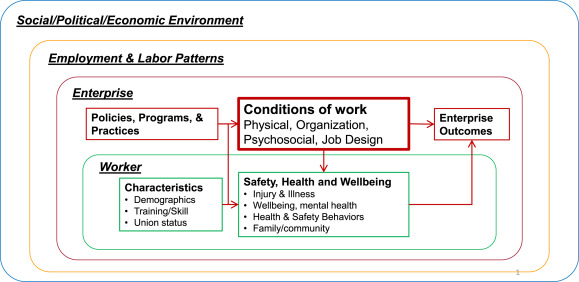
Conceptual model
Based on over 20 years of research in healthcare, construction, manufacturing, transportation, and other industries, the Center’s conceptual model identifies the many pathways through which conditions of work may influence health and safety. Central to the model is the recognition that safe, healthy workers may benefit their organization with increased productivity and reduced turnover, absences, and healthcare costs.
This framework guides the Center’s research and enables us to design and test interventions meaningful to both workers and employers. It also allows for solutions tailored to an organization’s specific conditions of work.
Center’s conceptual model for integrated approaches to protecting and promoting worker health

Our conceptual model is based on the premise that addressing multiple pathways in an integrated manner within the conditions of work will contribute to greater improvements in health outcomes than addressing each pathway separately.
Policies, programs, and practices may concurrently operate through many pathways affecting the conditions of work, including the physical work environment and the organization of work. Conditions of work are centrally located in the model as determinants of health and safety outcomes, also mediating the effects on health behaviors. Conditions of work are themselves influenced by enterprise and workforce characteristics, which are also likely to affect implementation of policies, programs, and practices. These integrated policies, programs, and practices may contribute to improvements in enterprise outcomes such as turnover and health care costs.
